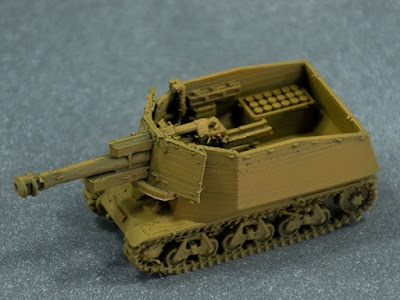It's a bit out of the period for Battlegroup NORTHAG (which is nominally set in 1983) but I really like Centurions so I made some anyway.
This is 3d printed on my Ender 3 from a model by M. Bergman. It's 1:150 scale, which I chose for all my BG-NORTHAG stuff because it's close enough to 1:144 to play on the same table, and because it makes for easier scaling.
I'm not sure exactly what sort of markings British armour would have had in the mid-'80s, but from the photos I've seen, any markings there were seem to be pretty small and low-viz, so I probably won't bother with any at all.
I have some Chieftains as well, of course. This is also 1:150 scale, and it's printed from a much less refined model than the Centurion, as it was intended for printing at 1:285 - 1:300 scale. However, it is Chieftain shaped, and it will do the job for me at tabletop distances.
I do have a more detailed model of a Chieftain in my collection, but its proportions are a bit out of whack, so I actually prefer the lower-detailed one.
I don't recall who it was who designed this model, unfortunately, and the .STL file format doesn't store useful metadata like author name at all.
Jumping back in time a bit, here's the Conqueror. It was intended as a long range heavy gun tank (with a massive, for the time, 120mm gun) to support the Centurions against the Soviets' JS-III, which had really put the shits up the allies when it appeared just after WWII.
I've elected to paint it in plain overall green (but not the dark Deep Bronze Green of peacetime). The plan was, at the time, to repaint everything in their battlefield disruptive livery, if and when it all kicked off. Assuming there was time, of course. Later on, in the late 1960s – early '70s, somebody decided that was a silly idea, and they started keeping everything in battle-ready paint all the time.
Leaping back ahead, this one is a Challenger 1, which only just squeaks in to BG-NORTHAG's 1983 setting.
It was supposed to be the replacement for Chieftain, but as it turned out it never made up more than a third of the British tank strength before it was superseded by the Challenger II.

















































